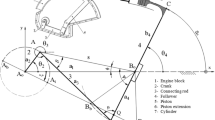Abstract
A new type of contrarotating propeller (CRP) system has been developed through the cooperative research work of five shipbuilding companies in Japan (Hitachi Zosen Corporation; Kawasaki Heavy Industries, Ltd.; Mitsui Engineering and Shipbuilding Co., Ltd.; NKK Corporation; and Sumitomo Heavy Industries, Ltd.). This paper describes a design system for an optimum CRP, which is one of the numerous outcomes of this work. The optimum design system is composed of three theoretical programs: (1) the design program of the optimum CRP; (2) the steady lifting surface program of the CRP; (3) the unsteady lifting surface program of the CRP. These theoretical programs will be discussed in the first part of the paper, and the design system supported by these theoretical programs will then be verified by comparing calculated and experimental results.
Similar content being viewed by others
References
Sasaki N (1988) Study on contrarotating propellers (3rd report) (in Japanese). Trans West Japan Soc Nav Archit 76:15–29
Murakami M, Kuroi M, Ando J et al (1991) Practical method of estimating characteristics of open-water propeller based on quasicontinuous method (in Japanese). Trans West Japan Soc Nav Archit 82:1–15
Nishiyama S, Sakamoto S, Fujino R (1991) Contrarotating propeller system for large merchant ships. 4th International Marine Systems Design Conference, vol 1, May 26–30, 1991, kobe, pp 395–412
Morgan WB (1960) The design of counterrotating propellers using Lerbs' theory. Trans SNAME 60:6–38
Manen JD van (1956) Contra-rotating propellers, Trans INA 98:327–344
Glover EJ (1967) Contrarotating propellers for high speed cargo vessels: a theoretical design study. North East Coast 83:75–89
Sasaki N, Ukon Y, Nakatake K (1988) Study on contrarotating propellers (2nd report) (in Japanese). Trans West Japan Soc Nav Archit 75:65–74
Nakatake K, Ueda K, Oda K et al (1982) On hydrodynamical force acting on rudder (in Japanese). Trans West Japan Soc Nav Archit 63:65–77
Sasaki N (1989) Study on contrarotating propellers (4th report) (in Japanese). Trans West Japan Soc Nav Archit 78:93–99
Manen JD van, Troost L (1952) The design of ship screws of optimum diameter for an unequal velocity field. Trans SNAME 60:442–468
Masaki C (1960) On the mathematical representation of a blade contour (in Japanese). Trans West Japan Soc Nav Archit 19:89–96
Nakamura N (1985) Estimation of propeller open water characteristics based on quasi-continuous method. J Soc Nav Archit Jpn 157:95–107
Yang CJ, Tamashima M, Wang GQ et al (1991) Prediction of the steady performance of contrarotating propellers by lifting surface theory. Trans West Japan Soc Nav Archit 82:17–31
Yang CJ, Tamashima M, Wang GQ et al (1992) Prediction of the unsteady performance of contrarotating propellers by lifting surface theory. Trans West Japan Soc Nav Archit 83:47–65
Lan CE (1974) A quasi-vortex-lattice method in thin wing theory. J Aircraft 11:518–527
Murakami M, Kuroi M, Ando J et al (1992) Practical quasicontinuous method to estimate unsteady characteristics of propeller (in Japanese). Trans West Japan Soc Nav Archit 84:23–36
Nakatake K, Kakinouchi T, Moriyama F et al (1984) Study on the equivalent two-dimensional wing (in Japanese). J Soc Nav Archit Jpn 156:50–59
Moriya T (1959) Introduction of aerodynamics (in Japanese). Baifu-kan, Tokyo
Ukon Y, Kurobe Y, Kudo T (1989) Measurement of pressure distribution on a conventional and a highly skewed propeller model under non-cavitating condition (in Japanese). J Soc Nav Archit Jpn 165:83–94
Sasaki N, Nakatake K (1987) Study on contrarotating propellers (1st report) (in Japanese). Trans West Japan Soc Nav Archit 74:129–142
Author information
Authors and Affiliations
Additional information
Translation of an article that appeared in the Journal of The Society of Naval Architects of Japan, vol. 180 (1996): The original article won the SNAJ prize, which is awarded annually to the best papers selected from the SNAJ Journal, JMST, or other quality journals in the field of naval architecture and ocean engineering.
About this article
Cite this article
Sasaki, N., Murakami, M., Nozawa, K. et al. Design system for optimum contra-rotating propellers. J Mar Sci Technol 3, 3–21 (1998). https://doi.org/10.1007/BF01239802
Received:
Accepted:
Issue Date:
DOI: https://doi.org/10.1007/BF01239802




